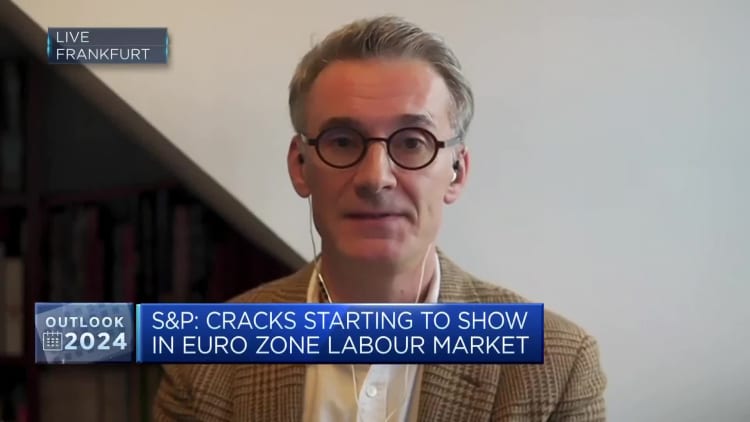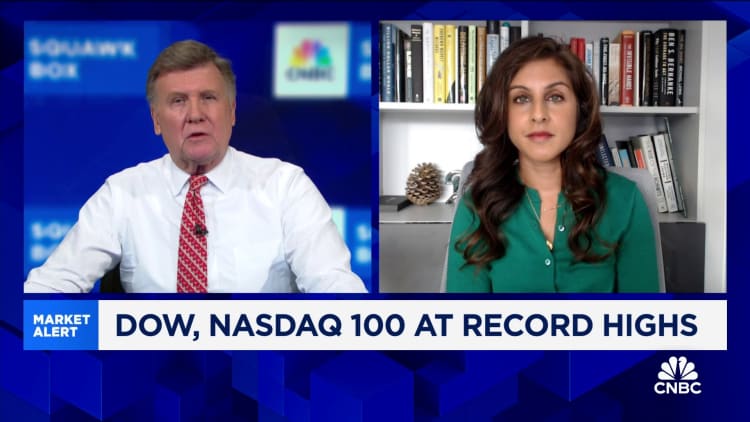Traders work on the floor of the New York Stock Exchange during morning trading on December 13, 2023 in New York City.
Michael M. Santiago | Getty Images
After nine straight sessions of gains, Wall Street suddenly took a turn around an hour and a half before the closing bell on Wednesday, leading the S&P 500 to suffer its worst daily losses since September.
The sell-off expanded into Asia-Pacific overnight, with Japan’s Nikkei 225 leading broad losses across the region, before stocks across Europe also slid into the red on Thursday morning.
The abrupt end of the recent rally, which was catalyzed by the U.S. Federal Reserve last week revealing that it had penciled in at least three cuts to interest rates in 2024, was chalked up to a variety of factors.
Some suggested Wednesday’s sell-off was as simple as investors taking profits after a nine-day bull run, in the absence of any discernible catalyst and with U.S. stocks widely seen as overbought.
Other market watchers pointed to a high volume of zero-day options trading as the death knell for the winning streak. These are risky put options, increasingly popular with retail traders, that expire on the same day they are traded.
Market monitor SpotGamma highlighted that bearish zero-day options flows were almost identical to overall flows on Wednesday, suggesting the bulk of the losses may be attributable to these derivative trades.
Some strategists also blamed the sell-off on a disappointing revenue outlook from delivery giant FedEx, often seen as a bellwether U.S. economic health, which missed expectations on both the top and bottom lines.

“The losses came as part of a broader risk-off move, and yesterday’s selloff saw investors grow even more confident about the chances of rate cuts from the Fed in 2024,” Jim Reid, global head of macro research at Deutsche Bank, said in an email Thursday.
“In fact, futures are now pricing a 92% chance of a cut by March, along with 152bps of cuts in total by the December 2024 meeting.”
That is the equivalent to six rate cuts across the year, which is typically the kind of pace of monetary loosening only seen during a recession, Reid noted.
Russ Mould, investment director at AJ Bell, said the combination of FedEx earnings and a “general shift in market focus from when rates will be cut to the underlying health of the economy” had tempered investor optimism.
“A downturn would be unwelcome news for corporate earnings even if central banks move on rates as the market hopes. For now, stocks are walking a tightrope to a hoped-for soft landing for the economy,” he said.

“However, a higher-than-expected core U.S. inflation reading tomorrow could tip us back into fretting about rates being higher for longer, while any downgrade to America’s final GDP estimate for the third quarter might elevate concerns about the health of the economy.”
The personal consumption expenditure (PCE) figure is the Fed’s preferred inflation gauge, and the central bank last week dialed back its inflation projections to project that will fall to 2.4% in 2024 and 2.2% by the end of 2025, eventually returning to its 2% target in 2026.
The market now expects the Fed to manage a “soft landing” of the U.S. economy, bringing inflation sustainably back toward 2% without triggering a recession.
Three rate cuts in 2024 ‘nonsense’
Peter Toogood, chief investment officer at Embark Group, said Wednesday’s stock market tumble was a “correction” after nine straight winning days, but warned that the market’s pricing of as many as six rate cuts from the Fed next year was “nonsense.”
“I don’t think there’s actually a particular meaningful slowdown in the U.S. I love the fact economists are apparently surprised by things — well get used to being surprised,” he told CNBC’s “Squawk Box Europe” Thursday.
“I don’t think it’s a slowdown, I think Asia’s also picked up, I think Europe and the U.K. it’s slightly different — there’s an element of that — but even in the U.K., there seems to be signs that things are OK. I’m not convinced the world’s falling apart and that the bond yield is telling you the right story about soft/hard landing.”

He flagged that core inflation over a three-month timeline is actually up in the U.S., and that policymakers still “haven’t broken the back of it,” arguing that the 2% target is unattainable given the lack of slack in the labor market.
“You’ve got a liquidity flush because I think we’re all scared of things going wrong, and they think they’ve cracked the back of inflation. I think the story for next year is they probably haven’t, so be more cautious than you have been this year,” Toogood told CNBC.
“This year was relatively easy after a grotty 2022, I think next year’s going to be lots more lumpy, and for me I’d still stick with the value side of the equation, not the growth side, shorter-duration assets, not longer ones.”
Credit: Source link












